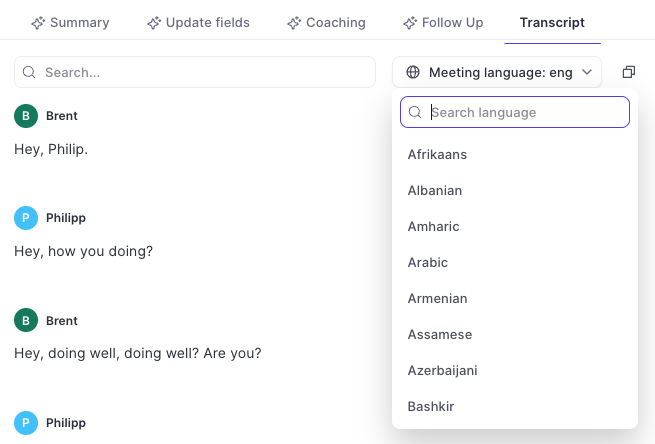Language Detection
Automated Language-Detection
- Weflow automatically detects your meeting language.
- You don't need to manually select language (unless you think that Weflow's language detection got it wrong).
- To change the language, go to the transcript tab and select your preferred language (see below).
Supported Languages
Weflow supports 96 languages. While accurate for most, some languages can be more experimental than others. While we aim to be transparent about the quality of the overall transcript accuracy, it is important to note that the quality increases when combined with an LLM (Large-Language Model i.e. an AI) to process the information. These models enhance the quality of a transcript and can make correct errors either almost entirely or at least to an extent that they do not become noticeable anymore.
Excellent accuracy (≤10% WER)
Arabic,Azerbaijani, Bulgarian, Bosnian, Mandarin Chinese, Czech, Danish, Greek, Estonian, Finnish, Filipino, Galician, Hindi, Croatian, Hungarian, Korean, Macedonian, Malay, Norwegian Bokmål, Romanian, Slovak, Swedish, Thai, Urdu, Vietnamese, Cantonese
Very Good accuracy (>10% to ≤25% WER)
Arabic,Azerbaijani, Bulgarian, Bosnian, Mandarin Chinese, Czech, Danish, Greek, Estonian, Finnish, Filipino, Galician, Hindi, Croatian, Hungarian, Korean, Macedonian, Malay, Norwegian Bokmål, Romanian, Slovak, Swedish, Thai, Urdu, Vietnamese, Cantonese
Moderate accuracy (>25% to ≤50% WER)
Afrikaans, Belarusian, Welsh, Persian (Farsi), Hebrew, Armenian, Icelandic, Kazakh, Lithuanian, Latvian, Māori, Marathi, Slovenian, Swahili, Tamil
Fair accuracy (>50% WER)
Amharic, Assamese, Bengali, Gujarati, Hausa, Javanese, Georgian, Khmer, Kannada, Luxembourgish, Lingala, Lao, Malayalam, Mongolian, Maltese, Burmese, Nepali, Occitan, Punjabi, Pashto, Sindhi, Shona, Somali, Serbian, Telugu, Tajik, Uzbek, Yoruba
What is WER?
Word Error Rate (WER) is a common metric for evaluating the performance of transcription models. It measures how accurately the system transcribes spoken language into written text.
The formula is:
WER = (S + D + I) / N
Where:
S = Number of substitutions (wrong words in place of correct ones)
D = Number of deletions (missing words)
I = Number of insertions (extra words added)
N = Total number of words in the reference (ground truth)
WER is expressed as a percentage, with 0% being perfect (no errors), and higher values indicating more errors.
Meaning of 10% WER
10% WER means that, on average, 1 in every 10 words transcribed by the model contains an error (substitution, insertion, or deletion).
For example, if a reference transcript has 100 words, approximately 10 words in the system's output will be incorrect. Since the transcripts purpose is not to be used e.g. for a publication but for processing via an LLM, a 10% WER can be considered excellent and return high-quality returns.
The same is true for a 10% to 25% WER model. Quality can become lower for models with a WER score between 30% - 50% though results will still be overall reliable.

